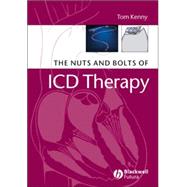The Nuts And Bolts of Icd Therapy
, by Kenny, Tom- ISBN: 9781405135115 | 1405135115
- Cover: Paperback
- Copyright: 11/18/2005
THE NUTS AND BOLTS OF ICD THERAPY builds on the series commenced with THE NUTS AND BOLTS OF CARDIAC PACING and offers a systematic approach to ICD therapy for clinician-readers with no formal training in cardiac rhythm management devices or electrophysiology. While this audience includes nurses and technicians (who often handle most of the routine chores of follow-up visits) it may also include cardiology fellows, medical students, and physicians who are not electrophysiologists.ICD stands for implantable cardioverter-defibrillator. A decade of clinical studies have gradually expanded the indications for these devices from "therapy of last resort" in 1986 (Medicare only approved them in cardiac arrest survivors who did not respond to medication) to broadened criteria in 1991 and again in 1999. In fact, right now, Medicare is reviewing another significant expansion (proposed September 2004) of ICD indications that would allow the device to be implanted in patients with compromised left-ventricular function, even if there was no documented evidence of any rhythm disorder.In short, the number of ICD patients is increasing sharply, particularly in the U.S. The number of electrophysiologists-physicians who specialize in the electrical system of the heart-is not increasing as dramatically. The result is that more and more ICD patients are being treated by physicians and staffs with little or no ICD training.Few academic courses even address the subject. Most clinicians learn about ICDs from colleagues or from training programs offered by manufacturers.Summary"Most people who get an ICD will have the implant performed by an electrophysiologist. But after that, most of them return to their primary physician or cardiologist, who may have little or no experience in ICD therapy and no obvious way to go about learning the subject," commented Tom Kenny. He has developed and taught numerous manufacturer-sponsored courses on ICD therapy, and knows first-hand the incredible demand for the subject and the level of knowledge of the average clinician.In actual clinical practice, there are hundreds of thousands of ICD patients being cared for by non-specialists who may not know enough about the devices to assure that the patient is receiving appropriate therapy. This book is aimed at all levels of healthcare professionals (cardiologists, non-cardiologist physicians, fellows, physician''s assistants, nurses, technicians and others) who need to know about the devices in the patients they treat.Even clinicians far removed from the world of cardiac rhythm management (dentists, surgeons) encounter ICD patients in their practice and may have to make special accommodations for the device.This book will treat the subject in a medically sound, professional, but familiar, friendly style. It will build, concept on concept, the fundamentals of ICD therapy. It will cover basics but also build up to more advanced concepts, so that this book will also be a great reference tool for even clinicians experienced in the care of ICD patients.OverviewAn ICD is primarily an implantable defibrillator; it monitors the heart and delivers a powerful jolt of energy (officially called "therapy delivery" but more accurately depicted by the slang term "shock") when the device detects a dangerously rapid and irregular heart beat. Defibrillators aim to treat sudden cardiac arrest, one of the "top five" major killers in the industrialized world. In that area, they are remarkably successful: defibrillators have a 99 percent efficacy rate.One issue in ICD therapy is determining who gets them. As one medical book puts it, one of the first symptoms of sudden cardiac arrest is death. Many people die of the "electrical accident" in the heart that causes sudden cardiac arrest without even knowing they have the condition. Identifying patients at risk is an ongoing scientific quest that has recently exploded to show that many hundreds of thousands of people are probably at risk of sudden c







